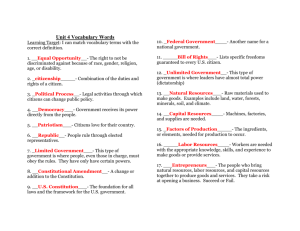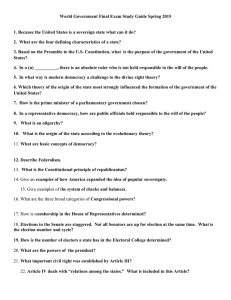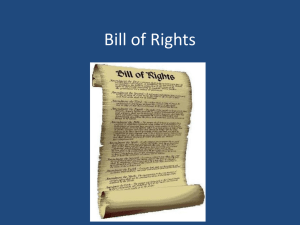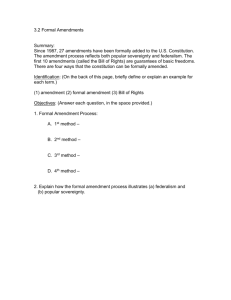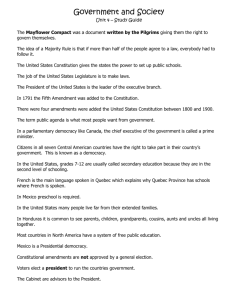Principles of American Democracy: CHs 1
advertisement
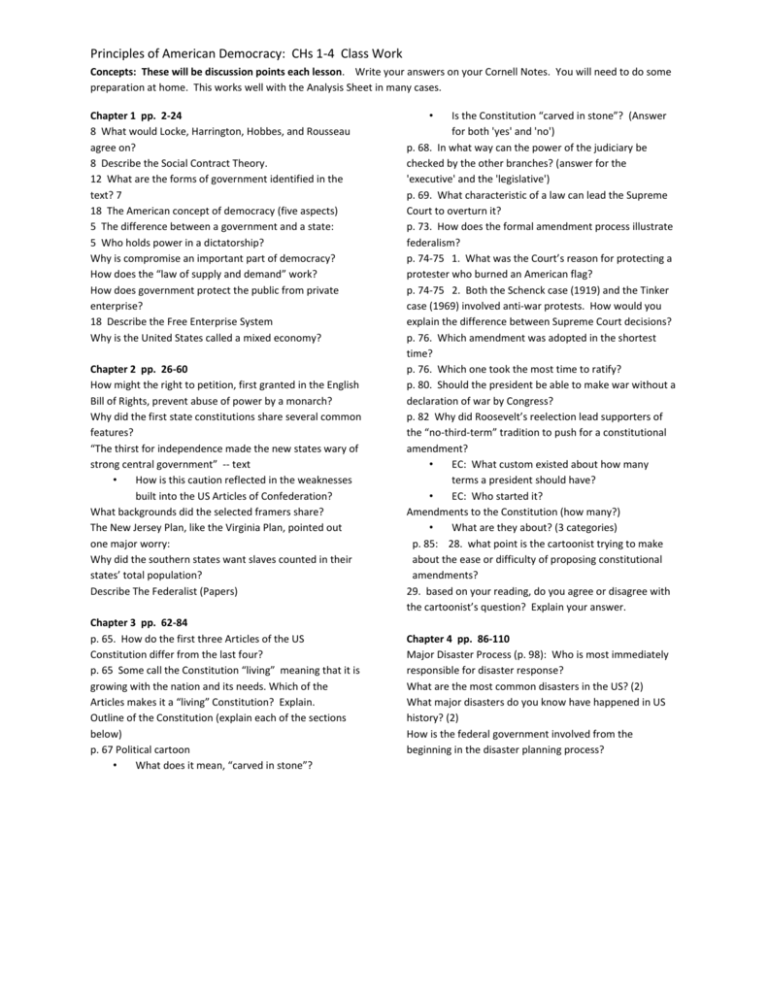
Principles of American Democracy: CHs 1-4 Class Work Concepts: These will be discussion points each lesson. Write your answers on your Cornell Notes. You will need to do some preparation at home. This works well with the Analysis Sheet in many cases. Chapter 1 pp. 2-24 8 What would Locke, Harrington, Hobbes, and Rousseau agree on? 8 Describe the Social Contract Theory. 12 What are the forms of government identified in the text? 7 18 The American concept of democracy (five aspects) 5 The difference between a government and a state: 5 Who holds power in a dictatorship? Why is compromise an important part of democracy? How does the “law of supply and demand” work? How does government protect the public from private enterprise? 18 Describe the Free Enterprise System Why is the United States called a mixed economy? Chapter 2 pp. 26-60 How might the right to petition, first granted in the English Bill of Rights, prevent abuse of power by a monarch? Why did the first state constitutions share several common features? “The thirst for independence made the new states wary of strong central government” -- text • How is this caution reflected in the weaknesses built into the US Articles of Confederation? What backgrounds did the selected framers share? The New Jersey Plan, like the Virginia Plan, pointed out one major worry: Why did the southern states want slaves counted in their states’ total population? Describe The Federalist (Papers) Chapter 3 pp. 62-84 p. 65. How do the first three Articles of the US Constitution differ from the last four? p. 65 Some call the Constitution “living” meaning that it is growing with the nation and its needs. Which of the Articles makes it a “living” Constitution? Explain. Outline of the Constitution (explain each of the sections below) p. 67 Political cartoon • What does it mean, “carved in stone”? • Is the Constitution “carved in stone”? (Answer for both 'yes' and 'no') p. 68. In what way can the power of the judiciary be checked by the other branches? (answer for the 'executive' and the 'legislative') p. 69. What characteristic of a law can lead the Supreme Court to overturn it? p. 73. How does the formal amendment process illustrate federalism? p. 74-75 1. What was the Court’s reason for protecting a protester who burned an American flag? p. 74-75 2. Both the Schenck case (1919) and the Tinker case (1969) involved anti-war protests. How would you explain the difference between Supreme Court decisions? p. 76. Which amendment was adopted in the shortest time? p. 76. Which one took the most time to ratify? p. 80. Should the president be able to make war without a declaration of war by Congress? p. 82 Why did Roosevelt’s reelection lead supporters of the “no-third-term” tradition to push for a constitutional amendment? • EC: What custom existed about how many terms a president should have? • EC: Who started it? Amendments to the Constitution (how many?) • What are they about? (3 categories) p. 85: 28. what point is the cartoonist trying to make about the ease or difficulty of proposing constitutional amendments? 29. based on your reading, do you agree or disagree with the cartoonist’s question? Explain your answer. Chapter 4 pp. 86-110 Major Disaster Process (p. 98): Who is most immediately responsible for disaster response? What are the most common disasters in the US? (2) What major disasters do you know have happened in US history? (2) How is the federal government involved from the beginning in the disaster planning process?

